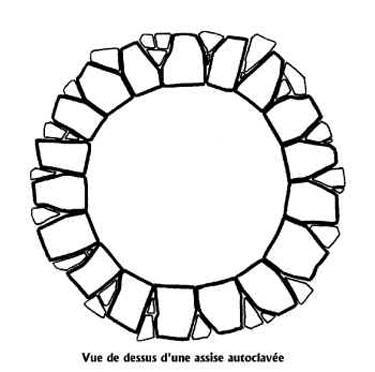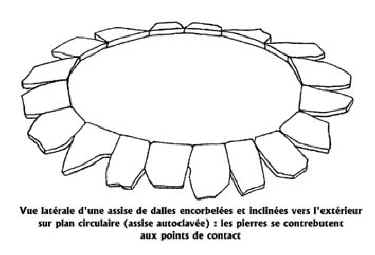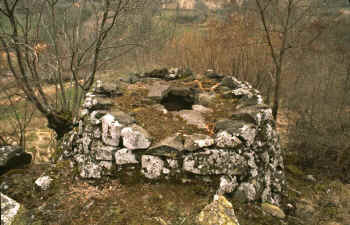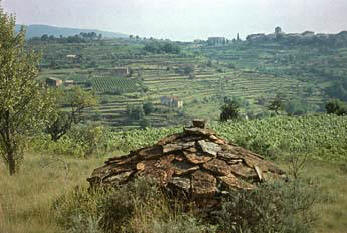|
THE VAULT OF CORBELLED AND OUTWARD-INCLINING DRY STONES Christian Lassure Dry-stone walling has been the preferred method of construction for the field walls and structures that characterize the agricultural landscape of stony regions. By combining with specific roofing techniques, mainly the vault of corbelled and outward-inclining stones and, to a lesser extent, the vault of stone voussoirs or keystone vault, it has also enabled a genuine peasant architecture to materialize in the form of dry-stone "cabanes" or huts. As shown by the French "cabanes" ("casèlas" of Aveyron, "oustalets" of the Cévenol Gard, "cabordes" of Doubs, "barracuns" of Corse-du- Sud, etc.) or the dry-stone huts of other European countries ("barraques" of Spain's Valencian province, "casedde" of Southern Italy's Puglia, "giren" of the Maltese Islands, "booley huts" of Western Ireland's Dingle Peninsula, etc.), the corbelled vault has been most popular with the self-building peasants or dry-stone craftsmen of the last two or three centuries, to roof space at the least possible cost. This type of vault, when constructed on a circular basis, obeys two principles: "the corbelling method" and "the method of the outward inclination". "The principle of corbelling" consists in laying the stones in each circular course with a slight overhang over the stones underneath. It is imperative that the centre of gravity of each stone should be kept within the depth of the underlying stone. To this effect, each corbel is laid with its long edges into the wall for counterweight, while its overhanging end is trimmed. It is also necessary for the corbels to be tapered so that their interfaces should radiate towards the centre of the circle. "The principle of the outward inclination" consists in giving the stones of each course a slight outward sloping (about 15°). (If the stones were laid flat, they would form, to be precise, a 'tas-de-charge' vault made up of horizontal courses). This inclination causes the slabs inside each course to buttress each other in a horizontal plane, resulting in a polygon of forces being closed: each course thus becomes self-binding and autonomous while being borne by the one below. The outward thrust exerted by each course is cancelled by piling up on top of it material that serves as abutment.
The succeeding layers curve inwards gradually until they almost meet, the final layer being topped by a single cap-stone. No formwork or framework is required in this vault with horizontal stress (as opposed to the conventional keystone vault which is with vertical stress). While the removal of the keystone from a vault of voussoirs will bring about the fall of the whole vault, the final cap-stone in a corbelled vault can be removed without causing the vault to collapse. It should be borne in mind that a dry-stone vault, whether corbelled or keystone, is in its turn concealed by an outside covering of slabs or flat stones after the technique of the 'double skin'.
Attempts have been made to contrast the corbelled vault and the keystone vault by calling the former 'false vault', as though the keystone vault were the only 'true' vault. In fact, the expression 'false vault' is to be reserved for a covering other than of stone (for example, of painted wood), imitating the form and appearance of a stone vault. The corbelled vault should be regarded as a vault in its own right, but a 'horizontal' one as opposed to the 'vertical' vault. BIBLIOGRAPHY LASSURE, Christian, 1977, 'Essai d'analyse architecturale des édifices en pierre sèche', in L'Architecture rurale en pierre sèche, suppl. No 1, pp. 1-27 et 36-60 (Paris: CERAPS) OBEREINER, Jean-Luc, 1977, 'Eléments pour servir à l'étude statique des voûtes de pierres sèches à encorbellements', in L'Architecture rurale en pierre sèche, suppl. No 1, pp. 28-36 (Paris: CERAPS) © CERAV To be referenced as :
home page sommaire definitions
|




